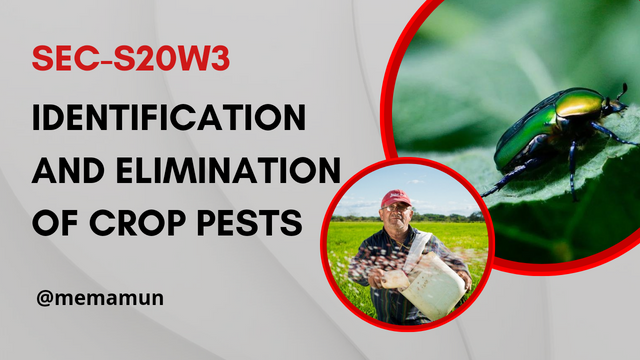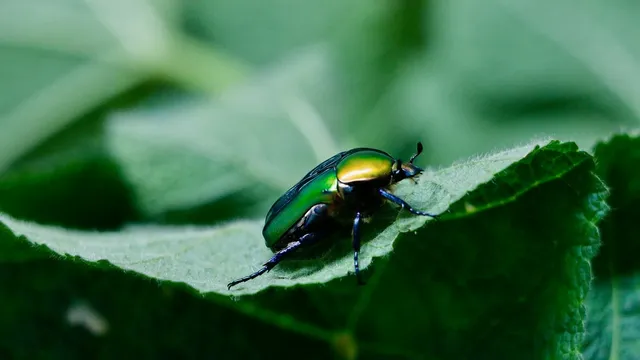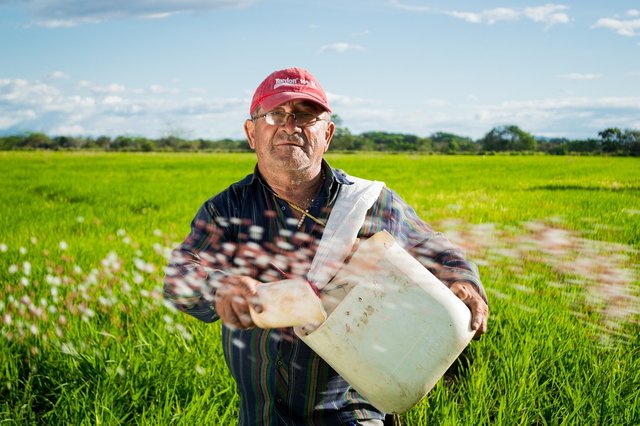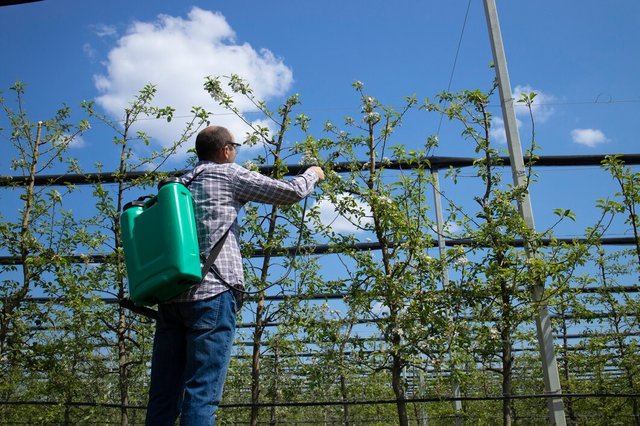SEC | S20W3: "Identification and Elimination of Crop Pests

Assalamu Alaikum dear brothers and sisters. Hope everyone is well. I am also well by the grace of Alhamdulillah Allah. So much for people to eat. Then why not eat pests. But everything has its limits. I will discuss those things. Before that, I invite some of my friends here. They are. @patjewell @suboohi @chant and @ripon0630 brothers. Your invitation.
When you visited the crop field, what pests did you observe there? How did you identify that it was a pest?
When I visit a crop field, I will definitely see some insects, we all know that insects attack the crop land and cause serious damage to the crop, usually spiders, fungal insects, beetle insects, lupert insects attack such insects in the crop land.
Spiders attack crops, beetle insects eat the leaves of the crop and damage it. Lupert insects destroy roots and stems. And fungal insects that attack crop leaves cause long-term damage to crops. This type of insect is usually seen in crop land. For identification of crop pests
First of all, we have to see if there are any insects on the crop or whether there are any insects around the crop.
In the second step, we have to identify the affected area, if we see any kind of insect on the crop, then we have to see what damage that insect has done to the crop. In this way, the damaged place should be identified.
In the third step, if we see holes on the leaves, and the color of the leaves is yellow, the leaves have dried up, then we have to understand that the crop has been attacked by insects.
In the fourth step, we have to see what color and look like the insects, how the insects behave and how they move, so that we can identify what it was an insect.
In the fifth step, we can take some insects for observation and experimentation, and study what insects they were.
This is how we can identify crop pests.
Which pesticides do you think are suitable for controlling the pests you observed in the field? Please express your own opinion. (Note: For your convenience, the names of the pesticide groups are mentioned above.)
There will be pests in the crop land, and harmful pests are more noticeable in it. Harmful pests destroy the leaves, roots, stems of the crop and cause serious damage to the crop. Therefore, different types of pesticides are used to prevent crop damage, and to destroy the harmful activities of pests. Insecticides are mainly applied according to the type of insect attack and the vulnerability of the insects. Notable pesticides are:-
Provalix: The insecticide acts against insects, and is fast effective.
Pyrethroids: This insecticide kit is used to kill insects immediately.
However, it is safest and healthiest to use organic pesticides. In the case of using any type of insecticide, caution should be used and knowing its good and bad aspects.
Describe the method of trapping insects by creating a pest trap using various natural materials (such as containers, adhesive substances).
Pests can be prevented in environmentally friendly ways and natural ways by creating various traps. Some of the notable traps are,
Water trap: This trap is mainly made for mosquitoes. First, water, lemon juice and soap are mixed in a container, then it should be kept around the crop land, so that mosquitoes and flying small insects will die in the container and drown.
Rubber rings and tape traps: In this trap, rubber rings or tapes are placed around the crop land, after which the insects get trapped in it and die.
Glue trap: To make this trap, first the adhesive substance should be placed inside a container, then the adhesive substance should be kept around the crop field, then the fruit and insects will be trapped in the adhesive container and killed.
In this way, it is possible to prevent pests by creating traps in an environmentally friendly way.
Discuss in detail which crops you think the use of bio-chemicals is beneficial and cost-effective.
It will be possible to produce useful and affordable fruits in agriculture using chemical and organic methods. A list of some such crops is given,
In paddy, organic fertilizers such as compost used in paddy play an active role in increasing soil fertility.
Organic pesticides used on vegetables, especially winter vegetables such as tomatoes and carrots, do not harm the soil, but prevent pests and protect the quality of the crop.
Fruits such as mango, are grown organically using Multani soil and organic fertilizers to increase the quality of the fruit.
The use of organic chemicals in organic methods has been proven over the ages to be eco-friendly as well as cost-effective.
Make a chart of which pesticides are used for which pest in your area and discuss with us. Special Note: If not aware of this, a permanent farmer or anyone involved in agriculture can take help.
I discuss this in detail through the table below. I request you to look carefully.
| Type of crop | Name of pest | pesticide | effectiveness | method |
|---|---|---|---|---|
| Rice | white fly | spinosad | Controls sucking insects | Apply on affected leaves |
| Wheat | aphid | Chlorpyrifos | Prevents pest growth | Wheat plants should be sprayed |
| Tomato | tomato hornworm | Malathion | Prevents pest growth | Tomatoes should be sprayed at the time of flowering |
| Sugarcane | sugarcane borer | chlorpyrifos | Prevents pest growth | Sugarcane plants should be sprayed at the growth stage. |
| pepper | aphid | Permethrin | Prevents pest growth | Pepper should be sprayed at the growth stage |
Different types of pesticides are used in my area, most notably imidacloprid, chlorpyrifos, carbaryl etc., these pesticides are used to prevent pests of crops. However, all precautions should be taken in the use of pesticides, such as the level of pesticide application, the rules of use, etc.
In the case of pesticide use, it is important to apply according to the correct dose of the insecticide. If not applied properly, there is a possibility of damage to crops and soil. Pesticides should be applied knowing what kind of effect the pesticide will have on the environment.




Upvoted. Thank You for sending some of your rewards to @null. It will make Steem stronger.
Observations and suggestions:
Five steps were very important to identify the insect. The fourth step will easily prove that it was an insect. Provalix insecticide is not widely used in all regions of Bangladesh but pyrethroids group of insecticides are widely used. The traps you mention are usually much more important for cropland. Water traps are not used as much nowadays but in the 80's and 90's water traps were the most widely used. Imidacloprid is used in all regions of Bangladesh but currently Cartap + Acetamiprid is more used. You have a nice discussion bro.
Feedback:
thank you dear brother, for your feedback 🥰🥰
0.00 SBD,
0.10 STEEM,
0.10 SP
Thank you for inviting me.
My grandpa was a farmer. He had a huge farm, and I remember so clearly how we children would go out with him to inspect the crop, take samples, and later to watch him and his workers go to work spraying the crop.
He always said that a farmer must have eyes in the back and front of his head.
The contribution of the farmer behind everything is immense. A farmer produces rice in 80 days of hard work. Step by Step.
Thank you very much for a nice comment. Be good.
Pleasure!☕
PS: I am always good